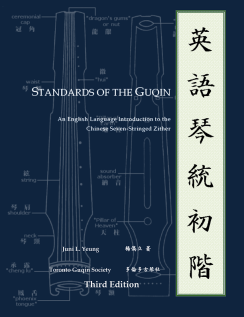
“Les Jeunes-Filles en Heptachordia Sinesis et Clavichordia” (琴の少女達)" Acrylic on Canvas, 42” x 30”, painted by Satsuki Shizuka, completed Dec 25, 2007.
Through the shroud of mystery, at times amateurs discussing Chinese music theory may get even the most basic terms and concepts mistaken. To this end, let us examine or review some basic terminology used when describing Chinese music: (Please also tell me if you would like to know any terms you may have encountered but don’t know how to translate!)
(中文): (Mandarin pinyin): (Cantonese ping1 jam1): English meaning
General concepts:
樂理: yue4 li3: ngok6 lei5: (modern term) musical theory
律呂: lv4 lv2: leot6 lui2: (classical term) musical theory (specifically, of temperamental measurement and tones)
調: diao4: diu6: Tuning, (performed key) gamut.
均 (韻): yun2: wan5: “Resonance”, mode, gamut.
The tones:
宮: gong1: gung1: “Do”, tonic of the mode.
商: shang1: seong1: “Re”, supertonic of the mode.
角: jue3: gok3: “Mi”, mediant of the mode.
中: zhong1: zung1: “Fa”, subdominant of the mode. (Used in Zhu Zaiyu’s Yuelv Quanshu, 1596)
徵: zhi3: zi2: “So”, dominant of the mode.
羽: yu3: jyu5: “La”, submediant of the mode.
和: he3: wo4: “Si”, leading note of the mode. (Used in Zhu Zaiyu’s Yuelv Quanshu, 1596)
On tones:
律: lv4: leot6: “Rule, measure”. 1. Refers to the 6 “Yang” tones of the 12-tone gamut; 2. A half-step.
呂: lv2: lui2: 1. Refers to the 6 “Yin” tones of the 12-tone gamut.
少: shao1: siu3: 1 octave higher.
倍: bei4: pui2: 1 octave lower.
清: qing1: ching1: 1. A half-step (lv) higher, sharp; 2. The prefix put in front of a tone name to indicate that it is a new tone. Used specifically for historical gamuts with more than 12 tones.
變: bian4: bin2: A half-step (lv) lower, flat.
On rhythm:
拍: pai1: paak3: “Clap, beat”. A standard unit of musical time in a given measure (ban).
板: ban3: baan3: “Board”. 1. A measure or “bar”; 2. The prime or leading beat of a measure.
眼: yan3: ngaan5: “Eye”. A minor beat or beats following the ban.










Recent Comments